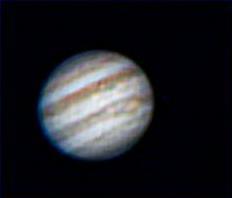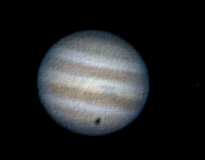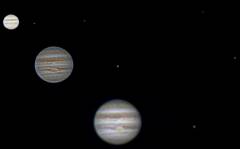| Jupiter, 2005 |
| HOME Best Lunar Planets Deepsky Misc Equipment Techniques Links |
| Venus Mars Jupiter Saturn |
| 2004 2005 |
| This page shows my various attempts at capturing Jupiter and its satellites during the 2005 apparition. During this time it was lower in the sky than in the previous year, making imaging more difficult. However for this series of images I have the 250mm Newtonian available, which improves the capture of details. Click the images to see full-sized ones. |
8 April, 2005 - Great Red Spot transit

|
On the night of 8 April 2005, I knew that Jupiter's great red spot would be crossing the planet (known as transiting) at a favourable time for me for imaging. I captured 21 AVIs using the 2x Barlow and all with the same settings. This was ideal for creating an animation, which is shown here. Each of the 21 frames of the animation was created from a stack of 675 frames out of 1350 captured with the ToUCam pro. I used K3CCDTools to automatically capture for 90 seconds every 4 minutes, which gave just enough interval between each to see some movement on the final animation, whilst not ending up with too many images to process. Each AVI was stacked in K3CCDTools, wavelets applied in Registax 3, sharpening and resizing in The Gimp. The frames were aligned using K3CCDTools again, and finally the animation was put together in The Gimp. Click the image to see the best frame from the animation |
| to top | home |
8 April, 2005 - double-sized imaging

|
I captured this image at the end of a long session during which I was imaging using my standard 2x Barlow lens. I decided to try out the effect of stacking two barlow lenses together to achieve twice as much magnification. This image is the result of capturing using my usual Celestron 2x Barlow, plus my spare 2x lens, into which I inserted the Celestron one. The focal ratio will then be nominally 19.2 (prime focus 4.8 x 4) although in practice the actual ratio will depend on the spacing of the lenses and the camera. The preview image was very indistinct, more so than usual, and darker (as would be expected from the higher effective focal length. However I captured 1350 frames as usual (15fps for 90 seconds) and stacked the best 500 in K3CCDTools. Following my usual procedure I applied wavelets in Registax, and finished processing in The Gimp, finally resizing down a little to improve the appearance. |
| to top | home |
5 April, 2005 - Jupiter At Opposition

|
Today Jupiter was at opposition -- meaning that it was positioned on a line formed by the Earth and the sun. This puts it at its closest point of the current aparition. Also, I was aware that the moon Ganymede was due to transit (cross) the planet, casting a shadow on the disc of jupiter. For both these reasons I wanted to get some images.
Although the weather was not good, it was not impossible to image and I captured some 15 AVIs through thin hazy cloud. I varied the camera settings during this time and ended up with some reasonable results. Although the seeing was poor, it was good enough to use my 2x Barlow lens, although I wasn't able to get good results with an extension tube (for greater magnification). This picture is the best I managed on the day, and shows the planet with Ganymede's shadow clearly visible although the moon itself isn't clear (it should be slightly to the left of its shadow). One of the other Galilean satellites, Io, is shown too. |
| to top | home |
5 April, 2005 - Ganymede Shadow Transit

|
The Galilean moon Ganymede transited the planet today, casting a shadow clearly visible on Jupiters disc. I could easily see the shadow in the telescope eyepiece, and it showed up well on the webcam. I collected 15 AVIs showing the progres of the shadow as it crossed the planet during approximately 39 minutes (from 00:39 to 01:19 Summer Time). In addition to showing the shadow, this sequence shows clearly how quickly Jupiter rotates.
The animation here shows the movement, although the colours and brightness of the individual frames are not well matched because of the changable conditions on the evening. The frames were aligned in K3CCDTools and animated in The Gimp.Click the animated image to the left, to see the whole sequence of frames. |
| to top | home |
22 March, 2005 - Jupiter and all four Galilean satellites

|
This picture was captured early in the evening, while I was using the satellites of Jupiter to focus my telescope in preparation for imaging the moon. I noticed the nice alignment of Jupiter's moons and decided to capture some frames to see what results I got.
The result is not bad. I stacked 450 frames captured at 10fps. The gamma was higher than normal at 50, which helped with the moons, although some details on Jupiter are lost at this setting. For this image I set the exposure very fast, to 1/250, together with a reasonable gain setting of 40% which I found was necesssary. These settings are somewhat different than usual, probably because Jupiter was low in the sky at the time. The frames were aligned and stacked in K3CCDTools, then slight wavelets applied in Registax 3. Final sharpening was in The Gimp. |
| to top | home |
18 March, 2005 - Three views of Jupiter and its moons

|
On the evening of 17th March, I captured my first images of Jupiter of the new season. For this apparition, the planet is lower in the sky than last time, which might make imaging harder. But this year I have a bigger telescope than last time, so these images should compare favourably with those from 2004. The famous Great Red Spot can be seen on all images, and the two larger ones show quite a few details, including a large dark blueish streak more-or-less above it in the Northern Equatorial Belt.
This image is a composite of three pictures, captured throughout the evening at different magnifications. The middle picture is actually the earlier of the three, at 01:23 on 2005-03-18, and was captured with a 2x Barlow lens on the Europa 250 f/4.8 Newtonian telescope. The field of view with the Barlow lens was sufficient to capture both Io and Europa in the positions they were in at the time. Zooming in by adding an extension tube between the Barlow lens and the camera, the lower picture (captured at 2003-05-18 01:36) only has room to show only one of those satellites, Io. However the settings on this image made for a more pleasing image with better colours and a clearer view of Io than the smaller image. Finally, at 01:51 2005-03-18, the wide-angle view at the top was achieved by removing the Barlow lens altogether. This time Callisto was visible in addition to Io and Europa. At this magnification the planet is brighter so the exposure must be reduced, which means it is more difficult to capture the moons. Consequently the settings I had to use have made it more difficult to resolve details on the planet, although the famous Great Red Spot can be seen to have moved to the right on the image. |
| to top | home |
 |
|
| All text and images copyright and may not be used without permission |
|